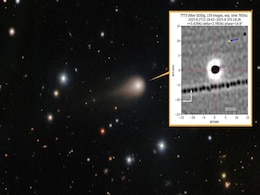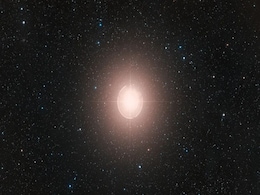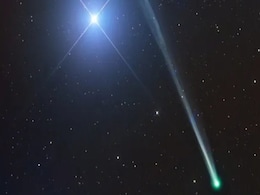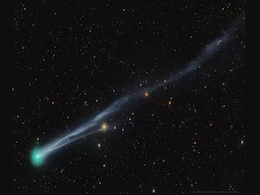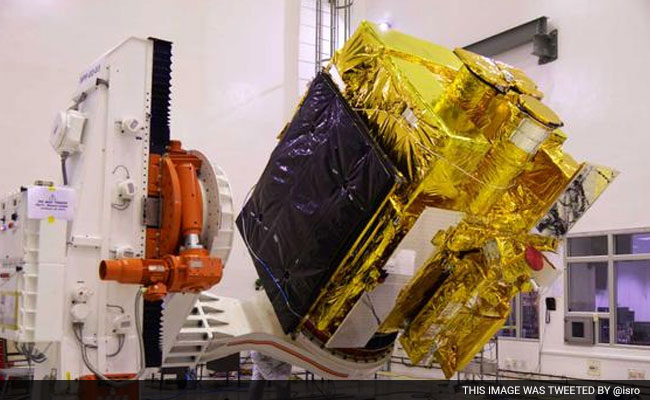Space Observatory
- All
- News
- Videos
- Web Stories
-

New Images of Interstellar Object 3I/ATLAS Show a Giant Jet Shooting Toward the Sun
- Sunday October 26, 2025
- Written by Gadgets 360 Staff
New telescope images show interstellar comet 3I/ATLAS ejecting a giant jet of gas and dust toward the Sun. Scientists say the phenomenon confirms its natural cometary behaviour, offering clues about how such ancient interstellar visitors react to solar heat.
-
 www.gadgets360.com
www.gadgets360.com
-

NASA Telescopes Capture First-Ever Companion Star Orbiting Massive Red Supergiant Betelgeuse
- Sunday October 26, 2025
- Written by Gadgets 360 Staff
Astronomers have detected a small companion star orbiting the red supergiant Betelgeuse using Hubble and Chandra observations. Dubbed “Betelbuddy,” the discovery reveals an extreme binary system that challenges existing models of stellar evolution and may offer clues to Betelgeuse’s future.
-
 www.gadgets360.com
www.gadgets360.com
-

NASA Confirms Brightening Comet SWAN Could Be Visible With Binoculars: When and Where to See It
- Monday October 20, 2025
- Written by Gadgets 360 Staff
Comet SWAN (C/2025 R2), discovered via NASA’s SOHO spacecraft, is rapidly brightening as it nears its October 20–21 Earth flyby. Skywatchers should look to the western horizon after sunset to spot its vivid green coma and tail — possibly visible to the naked eye in dark conditions.
-
 www.gadgets360.com
www.gadgets360.com
-

Astrophotographer Captures Stunning “Raging Baboon Nebula” in Deep Space
- Wednesday October 22, 2025
- Written by Gadgets 360 Staff
A stunning new image by Greg Meyer shows the “Raging Baboon Nebula” in Corona Australis, about 500 light-years away. Captured over 13 nights at Starfront Observatory in Texas, the photo reveals a baboon-like face formed by blue reflection nebulae and dark molecular dust.
-
 www.gadgets360.com
www.gadgets360.com
-

Rubin Observatory Adopts New AI Algorithm to Enhance Cosmic Imaging
- Tuesday September 30, 2025
- Written by Gadgets 360 Staff
Scientists have developed ImageMM, an algorithm tested on Hawaii’s Subaru Telescope and soon to be used at the Rubin Observatory. The system reduces atmospheric blur, producing sharper images for studying galaxies and dark matter. Researchers believe the technique could make ground-based astronomy nearly as precise as space telescopes
-
 www.gadgets360.com
www.gadgets360.com
-

India's 1st Multi-Wavelength Astronomy Observatory AstroSat Completes A Decade
- Tuesday September 30, 2025
- India News | Indo-Asian News Service
AstroSat -- India's first multi-wavelength astronomy satellite -- has completed 10 years of science observation, said the Indian Space Research Organisation.
-
 www.ndtv.com
www.ndtv.com
-

NASA Prepares 2025 Carruthers Mission to Explore Earth’s Hidden Hydrogen Halo
- Friday September 26, 2025
- Written by Gadgets 360 Staff
NASA’s Carruthers Geocorona Observatory, launching in 2025, will capture ultraviolet light from hydrogen atoms to map Earth’s faint geocorona. Operating a million miles sunward, it will study how solar activity drives atmospheric loss, improves satellite protection, and reveals clues to planetary habitability, providing critical insight for fut...
-
 www.gadgets360.com
www.gadgets360.com
-

New 'Quasi-Moon' Discovered in Earth Orbit May Have Been Hiding There for Decades
- Sunday September 14, 2025
- Written by Gadgets 360 Staff
Astronomers have identified asteroid 2025 PN7 as a possible quasi-moon of Earth, trailing our planet for nearly 70 years. At just 62 feet wide, it is the smallest and least stable quasi-satellite detected so far. Researchers believe advanced observatories like the Vera Rubin Observatory could uncover more hidden companions in Earth-like orbits
-
 www.gadgets360.com
www.gadgets360.com
-

NASA and NOAA Set to Launch Solar Probes for Space Weather Forecasting
- Friday September 5, 2025
- Written by Gadgets 360 Staff
In Sept. 2025, NASA and NOAA will launch three spacecraft aboard a Falcon 9 to the Sun–Earth L1 point. IMAP will map the heliosphere’s edge, the Carruthers Geocorona Observatory will study Earth’s exosphere, and SWFO-L1 will deliver real-time solar storm warnings. Together, they aim to improve space-weather science and safeguard technology on...
-
 www.gadgets360.com
www.gadgets360.com
-

Scientists Apply Stephen Hawking's Theory to Propose Detectable ‘Black Hole Morsels’ in Space
- Thursday August 14, 2025
- Written by Gadgets 360 Staff
A new study suggests “black hole morsels” — tiny, asteroid-sized black holes from cosmic mergers — could emit detectable bursts of Hawking radiation. Observatories like HESS, HAWC, and Fermi may already hold clues. Detecting them could unlock insights into quantum gravity, unknown particles, and even hidden dimensions beyond the Standard Mo...
-
 www.gadgets360.com
www.gadgets360.com
-

NASA Explores Industry Collaboration to Boost Swift Observatory’s Orbit and Extend Its Mission
- Friday August 15, 2025
- Written by Gadgets 360 Staff
NASA is partnering with U.S. firms to study boosting the Neil Gehrels Swift Observatory’s orbit, aiming to extend its scientific life and advance orbital servicing technologies. Funded through Phase III SBIR awards, the project explores cost-effective solutions while preserving Swift’s astrophysics role. Collaboration with Starfish Space may al...
-
 www.gadgets360.com
www.gadgets360.com
-

Twisted Jet Confirms Most Extreme Binary Black Hole System in the Universe
- Sunday August 10, 2025
- Written by Gadgets 360 Staff
Astronomers have confirmed that the blazar OJ 287 hosts the most extreme binary black hole system ever found. Using a global radio telescope array, they captured an ultra-sharp image showing a dramatically bent jet—evidence of two supermassive black holes locked in orbit. The system’s 12-year flare cycle and jet twists match predictions of a sm...
-
 www.gadgets360.com
www.gadgets360.com
-

NASA’s Solar Observatory Sees Two Eclipses in One Day
- Tuesday July 29, 2025
- Written by Gadgets 360 Staff
In a rare celestial event, NASA’s Solar Dynamics Observatory (SDO) captured two eclipses on July 25, 2025. First, at 2:45 UTC, the Moon passed between SDO and the Sun, covering about 62% of the solar disk. Just hours later, around 6:30 UTC, Earth itself blocked the Sun entirely from SDO’s perspective. These dual eclipses occurred during SDO’s...
-
 www.gadgets360.com
www.gadgets360.com
-

Hubble Captures First Images of Ancient Interstellar Visitor Comet 3I/ATLAS
- Monday July 28, 2025
- Written by Gadgets 360 Staff
Hubble has captured images of comet 3I/ATLAS, an ancient interstellar object likely 7 billion years old. As only the third known visitor from beyond the solar system, it offers rare insights into distant planetary systems. With its water ice and D-type asteroid-like dust, 3I/ATLAS is now under global scientific scrutiny before it vanishes back into...
-
 www.gadgets360.com
www.gadgets360.com
-

Chandra Spots Distant Baby Planet Losing Its Atmosphere Under Intense X-ray Assault
- Saturday July 19, 2025
- Written by Gadgets 360 Staff
NASA’s Chandra X-ray Observatory has captured a rare glimpse of TOI 1227 b, a young, Jupiter-sized exoplanet losing its atmosphere under intense stellar radiation. Just 8 million years old, the planet is shrinking rapidly as X-rays strip away its mass. Scientists warn it may become a barren rocky core in about a billion years.
-
 www.gadgets360.com
www.gadgets360.com
-

New Images of Interstellar Object 3I/ATLAS Show a Giant Jet Shooting Toward the Sun
- Sunday October 26, 2025
- Written by Gadgets 360 Staff
New telescope images show interstellar comet 3I/ATLAS ejecting a giant jet of gas and dust toward the Sun. Scientists say the phenomenon confirms its natural cometary behaviour, offering clues about how such ancient interstellar visitors react to solar heat.
-
 www.gadgets360.com
www.gadgets360.com
-

NASA Telescopes Capture First-Ever Companion Star Orbiting Massive Red Supergiant Betelgeuse
- Sunday October 26, 2025
- Written by Gadgets 360 Staff
Astronomers have detected a small companion star orbiting the red supergiant Betelgeuse using Hubble and Chandra observations. Dubbed “Betelbuddy,” the discovery reveals an extreme binary system that challenges existing models of stellar evolution and may offer clues to Betelgeuse’s future.
-
 www.gadgets360.com
www.gadgets360.com
-

NASA Confirms Brightening Comet SWAN Could Be Visible With Binoculars: When and Where to See It
- Monday October 20, 2025
- Written by Gadgets 360 Staff
Comet SWAN (C/2025 R2), discovered via NASA’s SOHO spacecraft, is rapidly brightening as it nears its October 20–21 Earth flyby. Skywatchers should look to the western horizon after sunset to spot its vivid green coma and tail — possibly visible to the naked eye in dark conditions.
-
 www.gadgets360.com
www.gadgets360.com
-

Astrophotographer Captures Stunning “Raging Baboon Nebula” in Deep Space
- Wednesday October 22, 2025
- Written by Gadgets 360 Staff
A stunning new image by Greg Meyer shows the “Raging Baboon Nebula” in Corona Australis, about 500 light-years away. Captured over 13 nights at Starfront Observatory in Texas, the photo reveals a baboon-like face formed by blue reflection nebulae and dark molecular dust.
-
 www.gadgets360.com
www.gadgets360.com
-

Rubin Observatory Adopts New AI Algorithm to Enhance Cosmic Imaging
- Tuesday September 30, 2025
- Written by Gadgets 360 Staff
Scientists have developed ImageMM, an algorithm tested on Hawaii’s Subaru Telescope and soon to be used at the Rubin Observatory. The system reduces atmospheric blur, producing sharper images for studying galaxies and dark matter. Researchers believe the technique could make ground-based astronomy nearly as precise as space telescopes
-
 www.gadgets360.com
www.gadgets360.com
-

India's 1st Multi-Wavelength Astronomy Observatory AstroSat Completes A Decade
- Tuesday September 30, 2025
- India News | Indo-Asian News Service
AstroSat -- India's first multi-wavelength astronomy satellite -- has completed 10 years of science observation, said the Indian Space Research Organisation.
-
 www.ndtv.com
www.ndtv.com
-

NASA Prepares 2025 Carruthers Mission to Explore Earth’s Hidden Hydrogen Halo
- Friday September 26, 2025
- Written by Gadgets 360 Staff
NASA’s Carruthers Geocorona Observatory, launching in 2025, will capture ultraviolet light from hydrogen atoms to map Earth’s faint geocorona. Operating a million miles sunward, it will study how solar activity drives atmospheric loss, improves satellite protection, and reveals clues to planetary habitability, providing critical insight for fut...
-
 www.gadgets360.com
www.gadgets360.com
-

New 'Quasi-Moon' Discovered in Earth Orbit May Have Been Hiding There for Decades
- Sunday September 14, 2025
- Written by Gadgets 360 Staff
Astronomers have identified asteroid 2025 PN7 as a possible quasi-moon of Earth, trailing our planet for nearly 70 years. At just 62 feet wide, it is the smallest and least stable quasi-satellite detected so far. Researchers believe advanced observatories like the Vera Rubin Observatory could uncover more hidden companions in Earth-like orbits
-
 www.gadgets360.com
www.gadgets360.com
-

NASA and NOAA Set to Launch Solar Probes for Space Weather Forecasting
- Friday September 5, 2025
- Written by Gadgets 360 Staff
In Sept. 2025, NASA and NOAA will launch three spacecraft aboard a Falcon 9 to the Sun–Earth L1 point. IMAP will map the heliosphere’s edge, the Carruthers Geocorona Observatory will study Earth’s exosphere, and SWFO-L1 will deliver real-time solar storm warnings. Together, they aim to improve space-weather science and safeguard technology on...
-
 www.gadgets360.com
www.gadgets360.com
-

Scientists Apply Stephen Hawking's Theory to Propose Detectable ‘Black Hole Morsels’ in Space
- Thursday August 14, 2025
- Written by Gadgets 360 Staff
A new study suggests “black hole morsels” — tiny, asteroid-sized black holes from cosmic mergers — could emit detectable bursts of Hawking radiation. Observatories like HESS, HAWC, and Fermi may already hold clues. Detecting them could unlock insights into quantum gravity, unknown particles, and even hidden dimensions beyond the Standard Mo...
-
 www.gadgets360.com
www.gadgets360.com
-

NASA Explores Industry Collaboration to Boost Swift Observatory’s Orbit and Extend Its Mission
- Friday August 15, 2025
- Written by Gadgets 360 Staff
NASA is partnering with U.S. firms to study boosting the Neil Gehrels Swift Observatory’s orbit, aiming to extend its scientific life and advance orbital servicing technologies. Funded through Phase III SBIR awards, the project explores cost-effective solutions while preserving Swift’s astrophysics role. Collaboration with Starfish Space may al...
-
 www.gadgets360.com
www.gadgets360.com
-

Twisted Jet Confirms Most Extreme Binary Black Hole System in the Universe
- Sunday August 10, 2025
- Written by Gadgets 360 Staff
Astronomers have confirmed that the blazar OJ 287 hosts the most extreme binary black hole system ever found. Using a global radio telescope array, they captured an ultra-sharp image showing a dramatically bent jet—evidence of two supermassive black holes locked in orbit. The system’s 12-year flare cycle and jet twists match predictions of a sm...
-
 www.gadgets360.com
www.gadgets360.com
-

NASA’s Solar Observatory Sees Two Eclipses in One Day
- Tuesday July 29, 2025
- Written by Gadgets 360 Staff
In a rare celestial event, NASA’s Solar Dynamics Observatory (SDO) captured two eclipses on July 25, 2025. First, at 2:45 UTC, the Moon passed between SDO and the Sun, covering about 62% of the solar disk. Just hours later, around 6:30 UTC, Earth itself blocked the Sun entirely from SDO’s perspective. These dual eclipses occurred during SDO’s...
-
 www.gadgets360.com
www.gadgets360.com
-

Hubble Captures First Images of Ancient Interstellar Visitor Comet 3I/ATLAS
- Monday July 28, 2025
- Written by Gadgets 360 Staff
Hubble has captured images of comet 3I/ATLAS, an ancient interstellar object likely 7 billion years old. As only the third known visitor from beyond the solar system, it offers rare insights into distant planetary systems. With its water ice and D-type asteroid-like dust, 3I/ATLAS is now under global scientific scrutiny before it vanishes back into...
-
 www.gadgets360.com
www.gadgets360.com
-

Chandra Spots Distant Baby Planet Losing Its Atmosphere Under Intense X-ray Assault
- Saturday July 19, 2025
- Written by Gadgets 360 Staff
NASA’s Chandra X-ray Observatory has captured a rare glimpse of TOI 1227 b, a young, Jupiter-sized exoplanet losing its atmosphere under intense stellar radiation. Just 8 million years old, the planet is shrinking rapidly as X-rays strip away its mass. Scientists warn it may become a barren rocky core in about a billion years.
-
 www.gadgets360.com
www.gadgets360.com

